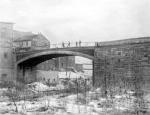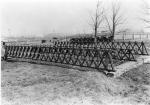![header=[Marker Text] body=[The first iron truss bridge in the U.S. was built in 1845 in the Philadelphia and Reading Railroad blacksmith shop, just south of here. It was designed for the railroad in 1844 by Richard B. Osborne. ] sign](http://explorepahistory.com/kora/files/1/10/1-A-1C5-139-ExplorePAHistory-a0b1z7-a_450.gif)
Mouse over for marker text
Name:
First Iron Bridge
Region:
Philadelphia and its Countryside/Lehigh Valley
County:
Montgomery
Marker Location:
SE corner, High and York Sts., Pottstown
Dedication Date:
May 21, 1953
Behind the Marker
Railroads run best on level surfaces. So the more that engineers could artificially smooth out Pennsylvania's many valleys, creeks, hills, and rivers, the more efficiently they would run. Bridge engineers, however, were slow to catch up to the demands of fast, heavy, and frequent railroad traffic.
The most common early railroad bridge form in Pennsylvania, if not in the nation, was the Burr truss, a combination of arches and crossing supports, or trusses that were all made of wood. Elaborate trellises of diagonal timbers perched on great masonry piers and abutments provided the support needed for the new fleets of freight trains.
Also popular was Ithiel Town's patented truss, introduced in 1820; a giant wooden latticework composed of four-inch by twelve-inch boards nailed together, in a repeating diagonal pattern. In the railroad's earliest years, these wooden forms were inexpensive, easily constructed, and sturdy enough for the light traffic of that era.
But wood had its limitations, which became a real problem as trains grew heavier and bridges aged and weathered. In 1840, Massachusetts engineer William Howe patented a truss bridge that, for the first time, incorporated iron as a structural element of its design. Howe's design included the traditional wooden diagonal supports, but he also employed stronger, threaded wrought-iron posts as vertical members. This bridge type quickly became the standard for railroad use until the spring of 1844, when brothers Thomas and Caleb Pratt patented a truss with diagonals of iron, and vertical posts of wood. Before long, trusses constructed entirely of iron became the railroad standard.
Howe and the Pratts were not the first to advocate the use of iron in bridges. English builders had been using iron in the construction of modest arch bridges since 1779. Engineers had long considered iron to be strong enough for posts under compressed weight, but they were wary of the cost and structural risks of bridges built entirely of iron. In 1839, local investors built America's first entirely iron bridge across Dunlap's Creek in Brownsville, Pennsylvania, for wagon traffic.
In the early 1840s, the Philadelphia and Reading needed to construct a bridge across a small creek along the Schuylkill River in Manayunk, to carry coal to Philadelphia. Richard Osborne, an iron worker in the company's Pottstown shops, became convinced that an entirely iron bridge, based on Howe's truss design, could best hold the tremendous weight of a coal train. In 1844, Osborne completed an elegant and complex ironwork lattice without using a stick of wood. This first iron railroad bridge in the nation opened the following year.
Osborne's construction proved to be sound. His bridge served the railroad into the twentieth century. (Today, portions of it are on display in the Smithsonian Institution's National Museum of American History.) Some other cast iron structures, however, were not so successful.
The failure of a cast iron bridge on the Erie Railroad in 1850, and another spectacular collapse of a similar model over the river Dee in England, resulted in a brief resurgence of wooden bridge building, and sent iron bridge designers back to their drawing boards. Before long, bridges featuring the massive girders, plates, and linked chains visible in modern bridge construction were being built across Pennsylvania and the nation.
The most common early railroad bridge form in Pennsylvania, if not in the nation, was the Burr truss, a combination of arches and crossing supports, or trusses that were all made of wood. Elaborate trellises of diagonal timbers perched on great masonry piers and abutments provided the support needed for the new fleets of freight trains.
Also popular was Ithiel Town's patented truss, introduced in 1820; a giant wooden latticework composed of four-inch by twelve-inch boards nailed together, in a repeating diagonal pattern. In the railroad's earliest years, these wooden forms were inexpensive, easily constructed, and sturdy enough for the light traffic of that era.
But wood had its limitations, which became a real problem as trains grew heavier and bridges aged and weathered. In 1840, Massachusetts engineer William Howe patented a truss bridge that, for the first time, incorporated iron as a structural element of its design. Howe's design included the traditional wooden diagonal supports, but he also employed stronger, threaded wrought-iron posts as vertical members. This bridge type quickly became the standard for railroad use until the spring of 1844, when brothers Thomas and Caleb Pratt patented a truss with diagonals of iron, and vertical posts of wood. Before long, trusses constructed entirely of iron became the railroad standard.
Howe and the Pratts were not the first to advocate the use of iron in bridges. English builders had been using iron in the construction of modest arch bridges since 1779. Engineers had long considered iron to be strong enough for posts under compressed weight, but they were wary of the cost and structural risks of bridges built entirely of iron. In 1839, local investors built America's first entirely iron bridge across Dunlap's Creek in Brownsville, Pennsylvania, for wagon traffic.
In the early 1840s, the Philadelphia and Reading needed to construct a bridge across a small creek along the Schuylkill River in Manayunk, to carry coal to Philadelphia. Richard Osborne, an iron worker in the company's Pottstown shops, became convinced that an entirely iron bridge, based on Howe's truss design, could best hold the tremendous weight of a coal train. In 1844, Osborne completed an elegant and complex ironwork lattice without using a stick of wood. This first iron railroad bridge in the nation opened the following year.
Osborne's construction proved to be sound. His bridge served the railroad into the twentieth century. (Today, portions of it are on display in the Smithsonian Institution's National Museum of American History.) Some other cast iron structures, however, were not so successful.
The failure of a cast iron bridge on the Erie Railroad in 1850, and another spectacular collapse of a similar model over the river Dee in England, resulted in a brief resurgence of wooden bridge building, and sent iron bridge designers back to their drawing boards. Before long, bridges featuring the massive girders, plates, and linked chains visible in modern bridge construction were being built across Pennsylvania and the nation.








